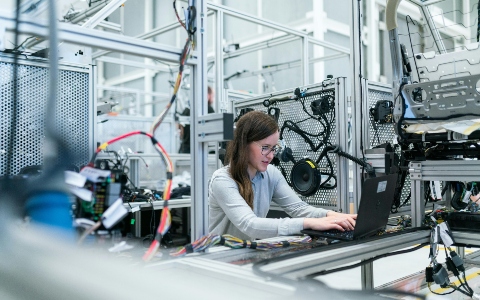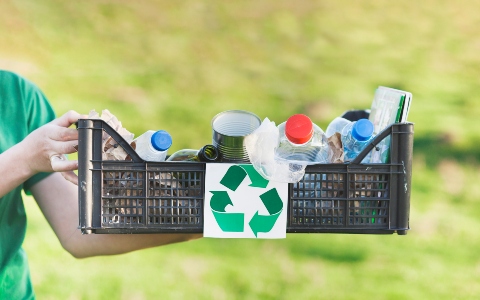
Remanufacturing and repair
Remanufacturing consists of returning a used product to its original performance, ensuring that it is equivalent to, or better than, the newly manufactured product.
From linear to circular, the future of business and the economy
Switching to the circular economy from the take-make-consume-dispose model — also known as the linear model — helps reduce waste, improve efficiency, reduce costs, and enhance long-term value creation. The World Economic Forum projects that, by 2025, recycling, reuse, and remanufacturing could help the economy unlock USD 1 trillion per year of untapped resource savings1.
In the final instance, the circular economy is a powerful tool to tackle climate change. Circular economy strategies can reduce global greenhouse gas emissions by an estimated 39% since about 80% of a product’s environmental impact is determined during the design phase2.
What is the circular economy?
The circular economy is a model of consumption and production that disconnects economic growth from resource use by extending products' overall life cycle through sharing, leasing, reusing, repairing, refurbishing, and recycling existing materials and products over a long period of time3.
1
Eliminate waste and pollution
2
Regenerate nature
3
Circulate products and materials for a long period of time
The adoption of circular economy models can help drive green growth, providing a dual dividend that benefits the environment and the job market5. According to the World Bank, the circular economy can help create between six and twenty million jobs worldwide.

The potential of a business to transition to a circular economy should be considered when investing, for three reasons:6
Regulatory landscape that benefits the adoption of a circular economy model
In March 2020, the European Commission launched the “Circular Economy Action Plan”, which is one of the main building blocks of the European Green Deal, Europe’s agenda for sustainable growth7.
On a global scale, regulation is expected to increase over the coming years. Specific global actions that promote the circular economy include the Global Alliance on Circular Economy and Resource Efficiency, which was initiated by the European Commission and the United Nations Environmental Program (UNEP), in coordination with the United Nations Industrial Development Organization (UNIDO)8.

Remanufacturing consists of returning a used product to its original performance, ensuring that it is equivalent to, or better than, the newly manufactured product.

Companies in the waste management sector can create new business models that minimize the quantity of waste produced.

Ecodesign is characterized by minimizing the environmental impact during the product life cycle, using reusable and recyclable materials, saving resources, and ensuring ecological traceability.
Conclusion
The transition towards a circular economy could generate USD 4.5 trillion of additional economic output by 2030 and USD 25 trillion by 205010.
The circular economy represents a great opportunity for businesses, investors, and governments to tackle the environmental crisis and generate economic growth. The switch from the linear model, based on the take-make-consume-dispose model, to the circular economy, where products are kept in the economy for as long as possible, helps reduce waste, improve efficiency, reduce costs, and enhance long-term value creation.
The regulatory drive should benefit companies that position themselves as practitioners of the circular economy in their business models. Well-positioned companies that are able to tap the circular economy opportunity should reap the benefits of this very necessary transition.
1. Towards the Circular Economy: Accelerating the scale-up across global supply chains. World Economic Forum.
2. The Circularity Gap Reporting Initiative. https://www.circularity-gap.world/
3. The circular economy in detail. Ellen MacArthur Foundation. https://ellenmacarthurfoundation.org/the-circular-economy-in-detail-deep-dive
4. Circular economy: definition, importance and benefits. European Parliament. https://www.europarl.europa.eu/news/en/headlines/economy/20151201STO05603/circular-economy-definition-importance-and-benefits#:~:text=The%20circular%20economy%20is%20a,reducing%20waste%20to%20a%20minimum
5. Putting young people at the center of the circular economy. World Bank. https://blogs.worldbank.org/jobs/putting-young-people-center-circular-economy
6. Closing the loop: Responsible investment and the circular economy. PRI. https://www.unpri.org/sustainability-issues/environmental-social-and-governance-issues/environmental-issues/circular-economy
7. Circular economy action plan. https://environment.ec.europa.eu/strategy/circular-economy-action-plan_en
8. Circular economy. https://environment.ec.europa.eu/international-cooperation/circular-economy_en
9. Circular Economy and Innovation. EIT Raw Materials. https://eitrawmaterials.eu/circular-economy-and-innovation/
10. The Circular Economy Could Unlock $4.5 trillion of Economic Growth. Accenture. 2015. https://newsroom.accenture.com/news/2015/the-circular-economy-could-unlock-4-5-trillion-of-economic-growth-finds-new-book-by-accenture
Important Legal Information
This document has been prepared by Banco Santander, S.A. ("Santander") for information purposes only and is not intended to be, and should not be construed as, investment advice, a prospectus or other similar information material. This material contains information compiled from a variety of sources, including business, statistical, marketing, economic and other sources. The information contained in this material may also have been compiled from third parties, and this information may not have been verified by Santander and Santander accepts no responsibility for such information. Any opinion expressed in this document may differ from or contradict opinions expressed by other members of Santander. The information contained in this material is of a general nature and is provided for illustrative purposes only. It does not relate to any specific jurisdiction and is in no way applicable to specific situations or individuals. The information contained in this document is not an exhaustive and formal analysis of the issues discussed and does not establish an interpretative or value judgement as to their scope, application or feasibility. Although the information contained in this document has been obtained from sources that Santander believes to be reliable, its accuracy or completeness is not guaranteed. Santander assumes no responsibility for the use made of the information contained herein.